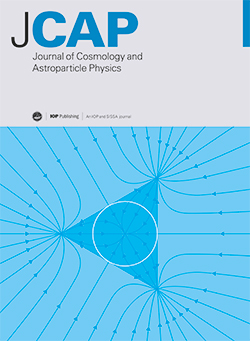未解析的伽马射线背景与大尺度宇宙结构之间的相关性的高意义探测
IF 5.9
2区 物理与天体物理
Q1 ASTRONOMY & ASTROPHYSICS
Journal of Cosmology and Astroparticle Physics
Pub Date : 2025-06-18
DOI:10.1088/1475-7516/2025/06/037
引用次数: 0
摘要
在过去的十年中,我们对γ射线天空的理解有了显著的提高,然而,未解析的γ射线背景(UGRB)仍然具有关于宇宙中最微弱的γ射线源的潜在丰富信息。与宇宙结构示踪剂的统计互相关可以间接确定最具γ射线背景特征的种群。在这项研究中,我们利用费米大面积望远镜(LAT)十多年的观测数据和暗能量调查(DES)三年的数据,分析了引力透镜追踪的γ射线背景与宇宙中物质分布之间的角相关性。我们检测到信噪比为8.9的相关性。大多数统计意义来自大尺度,首次证明了UGRB的很大一部分与通过弱透镜追踪的宇宙大质量星系团一致。耀变体为这一信号提供了一个合理的解释,特别是如果那些产生相关的耀变体位于大质量的光晕中(~ 1014M⊙),并且约占10 GeV以上的UGRB的30-40%。此外,我们观察到对弯曲γ射线能谱的偏好,对数抛物线形状优于幂律。我们还讨论了修改耀变体模型的可能性,以及包含额外γ射线源的可能性,例如恒星形成星系,错配的活动星系核或粒子暗物质。本文章由计算机程序翻译,如有差异,请以英文原文为准。
High-significance detection of correlation between the unresolved gamma-ray background and the large-scale cosmic structure
Our understanding of the γ-ray sky has improved dramatically in the past decade, however, the unresolved γ-ray background (UGRB) still has a potential wealth of information about the faintest γ-ray sources pervading the Universe. Statistical cross-correlations with tracers of cosmic structure can indirectly identify the populations that most characterize the γ-ray background. In this study, we analyze the angular correlation between the γ-ray background and the matter distribution in the Universe as traced by gravitational lensing, leveraging more than a decade of observations from the Fermi-Large Area Telescope (LAT) and 3 years of data from the Dark Energy Survey (DES). We detect a correlation at signal-to-noise ratio of 8.9. Most of the statistical significance comes from large scales, demonstrating, for the first time, that a substantial portion of the UGRB aligns with the mass clustering of the Universe as traced by weak lensing. Blazars provide a plausible explanation for this signal, especially if those contributing to the correlation reside in halos of large mass (∼ 1014M⊙) and account for approximately 30–40% of the UGRB above 10 GeV. Additionally, we observe a preference for a curved γ-ray energy spectrum, with a log-parabolic shape being favored over a power-law. We also discuss the possibility of modifications to the blazar model and the inclusion of additional γ-ray sources, such as star-forming galaxies, misalinged active galactic nuclei, or particle dark matter.
求助全文
通过发布文献求助,成功后即可免费获取论文全文。
去求助
来源期刊

Journal of Cosmology and Astroparticle Physics
地学天文-天文与天体物理
CiteScore
10.20
自引率
23.40%
发文量
632
审稿时长
1 months
期刊介绍:
Journal of Cosmology and Astroparticle Physics (JCAP) encompasses theoretical, observational and experimental areas as well as computation and simulation. The journal covers the latest developments in the theory of all fundamental interactions and their cosmological implications (e.g. M-theory and cosmology, brane cosmology). JCAP''s coverage also includes topics such as formation, dynamics and clustering of galaxies, pre-galactic star formation, x-ray astronomy, radio astronomy, gravitational lensing, active galactic nuclei, intergalactic and interstellar matter.
 求助内容:
求助内容: 应助结果提醒方式:
应助结果提醒方式:


